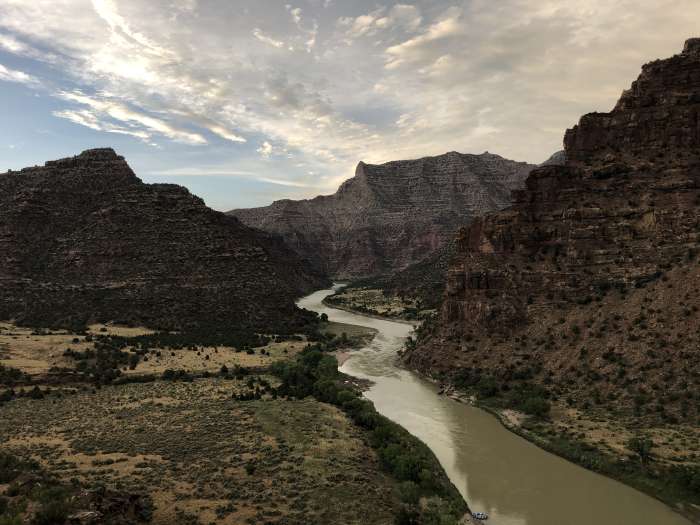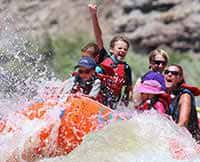Why Desolation Canyon is One of My Favorite Places on Earth
Desolation Canyon holds a special place in my heart. As a river guide, I’ve been extremely lucky to spend the past few summers floating the languid meanders and bony rapids of the canyon. By the time my mother finished her river guide career, she clocked in at 38 trips down the canyon, each measuring up to 86 miles. Building up muscles at the oars and buzzing through flatwater at the motor, I’ve managed 11 trips and counting down ole Deso.
The Green River runs in my blood, yet the canyon that shelters it is always eager to teach me another lesson. John Wesley Powell, the first white explorer to navigate the canyon in 1869, named it “desolation” for a reason; the sparse, intimidating landscape can best be described as, well, desolate.
The canyon itself teems with the history of native peoples, rugged farmers, and famous outlaws. About 10 miles from the start point at Sand Wash Recreational Area, the Green River gives way to towering stepped walls, boasting wild rock formations and shades of green that seem out of place in a desert setting. These vertical monuments that rival the Grand Canyon offer precarious refuge for wildlife such as pinyon pines, juniper trees, bighorn sheep, black bears, and even wild horses.
Accompanied by the impressive desert creatures are the impressive weather patterns. In this canyon, I’ve seen rain, snow, scorching sun, hurricane-force wind, and temperatures soaring indecisively within a 40-degree range during the day. Like the desert dwellers who came before, the canyon continues to welcome those with a sense of adventure.
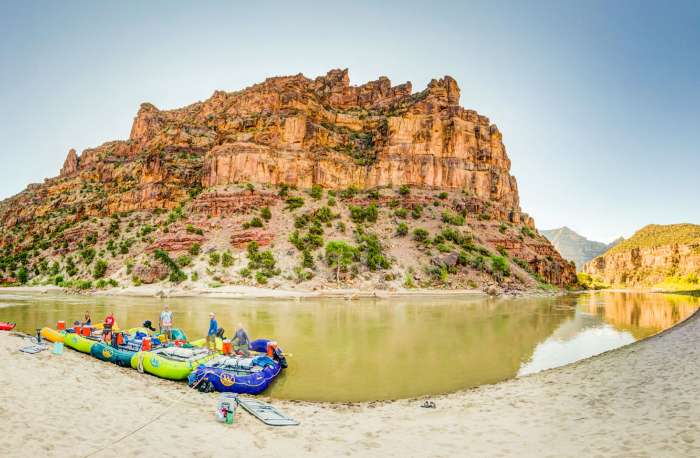
Expect the Unexpected
Whether you’re a seasoned camper or first-timer looking for a unique outdoor experience, a trip down Desolation Canyon can satisfy any level of “adventure lust”. However, be aware that on any river trip (especially in the desert), once you lose sight of civilization, you’re at the mercy of Mother Nature for the next 3+ days. The river guides do their darndest to prepare for any weather, equipment hazard, or freak disaster that could happen, but (as part of the adventure) anything could happen, and the best we can do is work with what we got. You’ll find there can be a lot of fun to be had in unexpected situations on the Green River. On a Desolation Canyon trip my husband Grant led, a raft got stuck on a rock in the middle of a rapid. As he guided his own boat down the rapid, he threw a bag of rope to the stuck boat, with the intent of towing it off the rock. A passenger grabbed the rope, clutched the daylights out of it and crouched into the bow, not knowing the end of the rope was meant for a much stronger anchor like a boat frame. Like a cork popping off a champagne bottle, the passenger launched from the boat and flopped over the bow (still clutching the rope), plopping immediately into the water. After an involuntary swim in the rapid accompanied by rowdy laughs from other passengers, he hooted and hollered and said it was the most fun he’d had the whole trip.
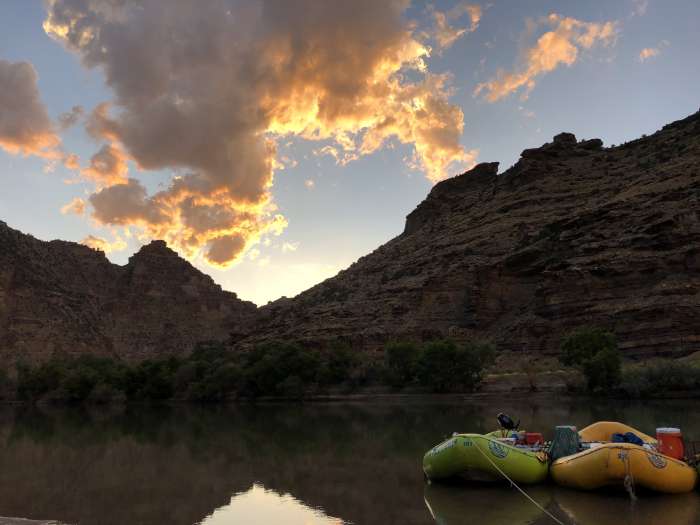
Rock Creek Ranch
The historic Rock Creek Ranch, built near the 1930’s and formerly maintained by the Swedish Seamount brothers, offers a glimpse into the lives of true adventure-seekers amidst a time of advancing technology. Looking at the remains of small, huddled cabins on a bank that could hardly be called farmland enclosed by looming cliffs, you can’t help but wonder how that miniscule development survived, let alone got there in the first place. It may remind you of a set for an old western movie. Yet, in part because of proximity to a freshwater spring called Rock Creek, irrigation techniques provided survivable crops and fruit trees like cherry and mulberry. The mulberry trees still produce edible fruit to this day. One trip in late May, the other guides and I were pleasantly surprised to find ripe juicy mulberries on the ground below the trees. Determined to land a decent haul, we shook the tree as hard as we could as another guide immediately took off his shirt and held it outstretched to catch the berries. Though the shirt was sacrificed to irreparable purple stains, we got to share the Rock Creek mulberries amongst ourselves and the passengers, staining our hands and tongues the same color in the process. The beach that skirts the property serves as a relaxing, shady lunch spot after exploring the ranch.
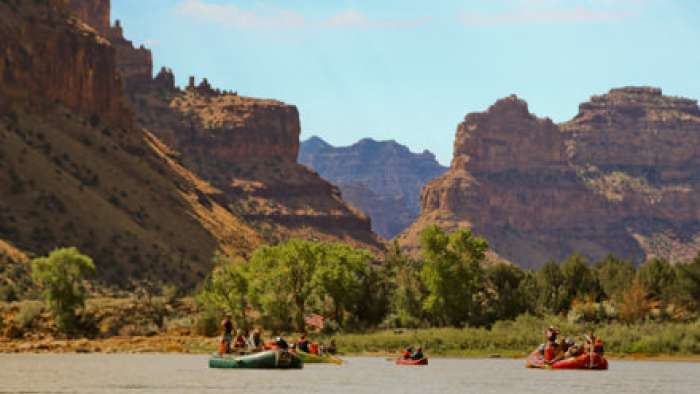
McPherson Camp
“I can’t forget the thrill of setting up for a run through the rapid and hitting it straight on - the breathtaking beauty of the early morning light on the cliffs, the wildlife that makes all of it worth it ... bringing an open mind - just how beautiful it is to see the whole McPherson Ranch valley open up before you as the canyon widens from the narrow Three Canyon section … seeing the wonder in nature - away from phones - I think I'm waiting to understand what the blessings of the trip are.... but that's just me.” – Amy Hansen, former Western River guide
As the boats around the corner of a sandstone wall to river right (facing downstream), the canyon unfolds a panoramic view of McPherson Ranch, nestled in the Florence Creek valley. Formerly cultivated by desert rancher Jim McPherson in 1889, the land has since been reclaimed and developed into a riverside lodge by the Ute/Ouray tribe, which was abandoned due to funding issues. There are a plethora of outlaw stories to be heard about the McPhersons’ encounters with the likes of Flat Nose George, Butch Kassidy, and several others making a getaway through the canyon. More can be read about the McPherson ranch in this article: https://truewestmagazine.com/outlaw-ranch/
The camp itself is across the river from the ranch, an elevated beach behind a seasonal sandbar island. My best memories of this camp involve the sandbar island; the seasonal flows may barely cover it, making it a low-current shallow cove great for wading, water-fights, beach-vacation style floating with beverage in hand, and relaxing in the blazing heat. If you’re lucky, an inflatable kayak edition of king-of-the-hill may take place between guides and younger passengers. Other times, the sandbar may be totally exposed, allowing ample space for games and better bathing access.
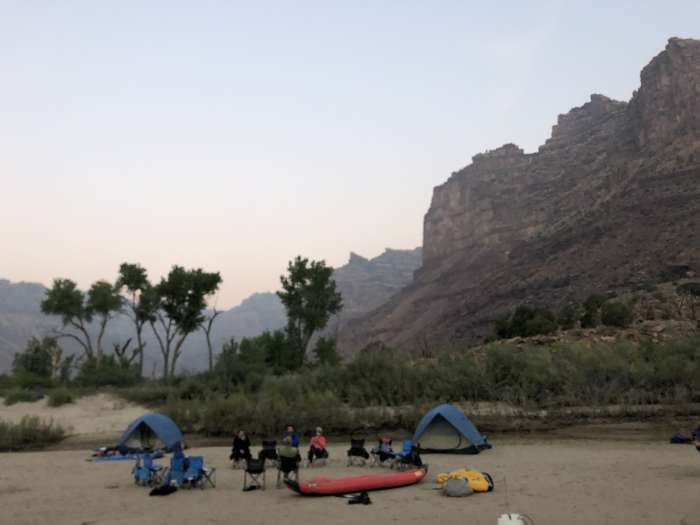
Wire Fence Rapid
There’s a child-like thrill that comes when you hear a thundering rapid around the next corner. It’s like riding up to the first big drop of an amusement park ride. Even if you’ve done it a million times, that feeling of adrenaline always resurfaces before you catch that glimpse of whitewater. Near the abrupt transition from Desolation Canyon to Gray Canyon, Wire Fence Rapid is a narrow, chute-like waterway on the left side of a wide rock field. Rated as a class III rapid (out of five, one being the easiest), the oarswoman/man or inflatable kayak passenger is in for a mini splash mountain-type experience. A half-submerged boulder on river left marks the entrance of the rapid. As the boat approaches the drop-in point, a smooth hydraulic highway can be seen plummeting into frothing whitewater. Once the correct entrance angle is achieved, the boat is swiftly carried down the chute and bucked around by roller-coaster waves. The rapid quickly subsides into a placid current, leading into another chute-like class III around the next bend called Three Fords. Easy enough to swim through yet big enough to give a good splash, Wire Fence Rapid has stayed on my list of favorites throughout my river guide years.
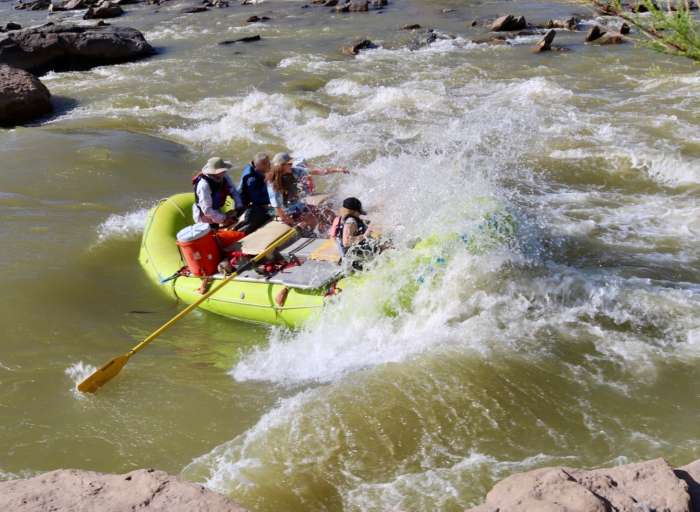
Fremont Petroglyphs
A short hike from the river, thousands of Fremont petroglyphs can be found on areas of sandstone (many times carved under ledges to prevent erosion and sun damage). The Fremont people (named after the man credited with discovering remains of the tribe itself) inhabited the land from around 600 to 1200 A.D., living as semi-nomadic and moving with the change of the seasons. As we show respect to the relics of ancient inhabitants, it is even more important to respect the present native inhabitants who still claim the land. The Ute/Ouray tribe owns the land spanning the left side of the river about 70 miles down. Until recently, recreational boaters were granted access to camping on their side, but because of illegal poaching and campers leaving sites unkempt, the tribe has shut off public access on the left side. That means less camping for the dozens of private and commercial trips embarking each week, but the good news is there are many great beaches and beautifully preserved petroglyphs on the accessible side. Scenes of bighorn sheep, sun-like spirals, and sunflower stems thought to be used as harvest trackers can be seen etched into the rocks in places such as the Big Tree, Flat Canyon, and Price River Confluence areas.
More can be read about the history of Green River peoples at this article:
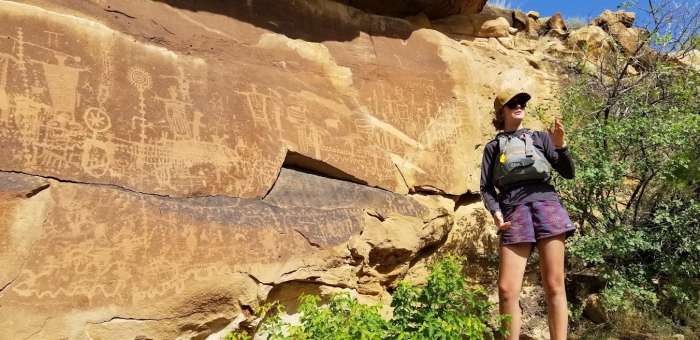
Three Canyon Overlook
The Three Canyon beaches are easily the most coveted camp spots in Desolation Canyon. Expanding like a large beach volleyball court amidst a backdrop of desert vegetation, the upper Three Canyon beach triggers daydreams of every beach activity you can imagine. When we’re lucky enough to snag that camp spot, the group is blessed with access to a trailhead of a once-in-a-lifetime hike to a scenic overlook witnessed only by river runners. Although this hike is not a light stroll (we rank it as moderate to advanced) and involves steep, rocky terrain, the view at the end is unforgettable. The whole river becomes visible right before your eyes, as well as its ancient winding path to the left. Three Canyon was formed by the river in its younger years; its path created a wide double-canyon meander (the third canyon giving the name “Three Canyon” can be seen on the river’s other side) that slowly dried up as the river bored its way through the southward cliffs. Many guides like to facilitate five minutes of meditation at the overlook, allowing for passengers to experience the true, arid silence of the desert. I’ve been told by many passengers at the conclusion of trips that those five minutes were the highlight of the whole week.
Desolation Canyon is the perfect introduction to river rafting. For any river runner, it holds a place at the top of their bucket list for good reason. The trip is extremely family-friendly and a great option for most ages. Although there are many other river trips known for their epic whitewater, nothing quite compares to the scenery and history of Deso. Throw on those river sandals and get some sand in your hair, you won’t regret it!
